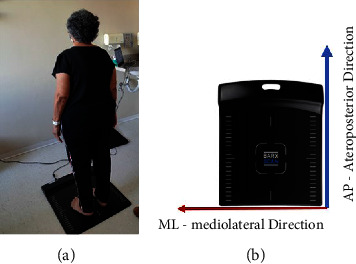诊断为单侧膝骨关节病患者的姿势控制及其与跌倒风险的关系分析。
IF 1.2
Q3 ORTHOPEDICS
引用次数: 0
摘要
引言:膝骨关节病,无论是轻微的还是明显的,在日常生活活动中都会改变膝关节的稳定性和性能,从而阻碍两足姿势的维持。然而,关于膝关节骨性关节炎如何影响静态平衡,文献中仍然存在空白。目的:分析诊断为单侧膝关节骨关节病的老年人姿势控制的表现。材料和方法:40名男女老年人参加了本研究,分为两组,每组20名老年人。第1组(G1)由诊断为单侧膝骨关节炎的老年患者组成。尽管进行了保守治疗,但他们的病情没有得到足够的改善,因此临床建议进行全膝关节置换术(TKA)。G2组由20名老年人组成,平均年龄71.09岁 年,被认为是活跃的,没有膝关节骨关节炎的诊断,并进行体育活动。在Baroscan压力平台的帮助下,在睁开眼睛和闭上眼睛的两足姿势控制过程中,评估前后方向(COPAP)和中外侧方向(COPML)上的压力中心(COP)位移和压力中心位移面积。结果:在睁开眼睛和闭上眼睛的姿势控制过程中,与G2组相比,G1组在前后方向COPAP(p=0.007)和中外侧方向COPML(p=0.033)上的COP位移更大。关于COP的位移面积,在睁开眼睛的两足姿势控制期间,G1组的位移面积(p=0.002)比G2组大。对于闭眼的情况,两组表现出相似的行为,这导致目前没有统计学上的显著差异。结论:研究结果表明,单侧膝关节骨性关节炎影响两足动物的姿势控制和需要这种静态平衡的日常生活活动,因为来自体感系统的信息减少,导致需要身体控制的任务的稳定性,并增加跌倒的风险。从临床角度来看,研究结果表明,评估两足姿势控制可以帮助骨科医生评估单侧膝骨关节病患者的关节稳定性。本文章由计算机程序翻译,如有差异,请以英文原文为准。

Analysis of Postural Control in Patients Diagnosed with Unilateral Knee Osteoarthrosis and Its Relationship with the Risk of Falls.
Introduction Knee osteoarthrosis, whether subtle or marked, appears to alter the stability and performance of the knee joint in activities of daily living that prevent the maintenance of bipedal posture. However, there is still a gap in the literature as to how knee osteoarthritis can affect static balance. Objective To analyze the performance of postural control in elderly diagnosed with unilateral knee osteoarthrosis. Materials and Methods 40 elderly people of both sexes participated in this study, divided into two groups containing 20 elderly each. Group 1 (G1) consists of elderly patients who have received a diagnosis of unilateral knee osteoarthritis. Despite undergoing conservative treatment, their condition has shown insufficient improvement, leading to a clinical recommendation for total knee arthroplasty (TKA). The G2 group was made up of 20 elderly with an average age of 71.09 years, considered active, who do not have a diagnosis of osteoarthritis in the knee joint and practice physical activity. With the aid of a Baroscan pressure platform, the center of pressure (COP) displacement in the anteroposterior (COPAP) direction and mediolateral direction (COPML) and the area of center of pressure displacement were evaluated during bipedal postural control with eyes open and eyes closed. Results During postural control with eyes open and eyes closed, the G1 group showed greater displacement of the COP in the anteroposterior direction—COPAP (p = 0.007)—and mediolateral direction—COPML (p = 0.033)—when compared to the G2 group. As for the area of displacement of the COP, group G1 presented a larger area of displacement (p = 0.002) than group G2 during bipedal postural control with open eyes. For the condition with eyes closed, both groups showed similar behaviors, which resulted in no present statistically significant differences. Conclusion The results suggest that unilateral knee osteoarthritis influences bipedal postural control and activities of daily living that require this static balance, since information from the somatosensory system is reduced, resulting in stability of tasks that require body control and promoting the risk of falls. From a clinical perspective, the results suggest that the assessment of bipedal postural control can assist orthopedic physicians in assessing joint stability in patients with unilateral knee osteoarthrosis.
求助全文
通过发布文献求助,成功后即可免费获取论文全文。
去求助
来源期刊

Advances in Orthopedics
ORTHOPEDICS-
CiteScore
2.40
自引率
0.00%
发文量
36
审稿时长
21 weeks
期刊介绍:
Advances in Orthopedics is a peer-reviewed, Open Access journal that provides a forum for orthopaedics working on improving the quality of orthopedic health care. The journal publishes original research articles, review articles, and clinical studies related to arthroplasty, hand surgery, limb reconstruction, pediatric orthopaedics, sports medicine, trauma, spinal deformities, and orthopaedic oncology.
 求助内容:
求助内容: 应助结果提醒方式:
应助结果提醒方式:


